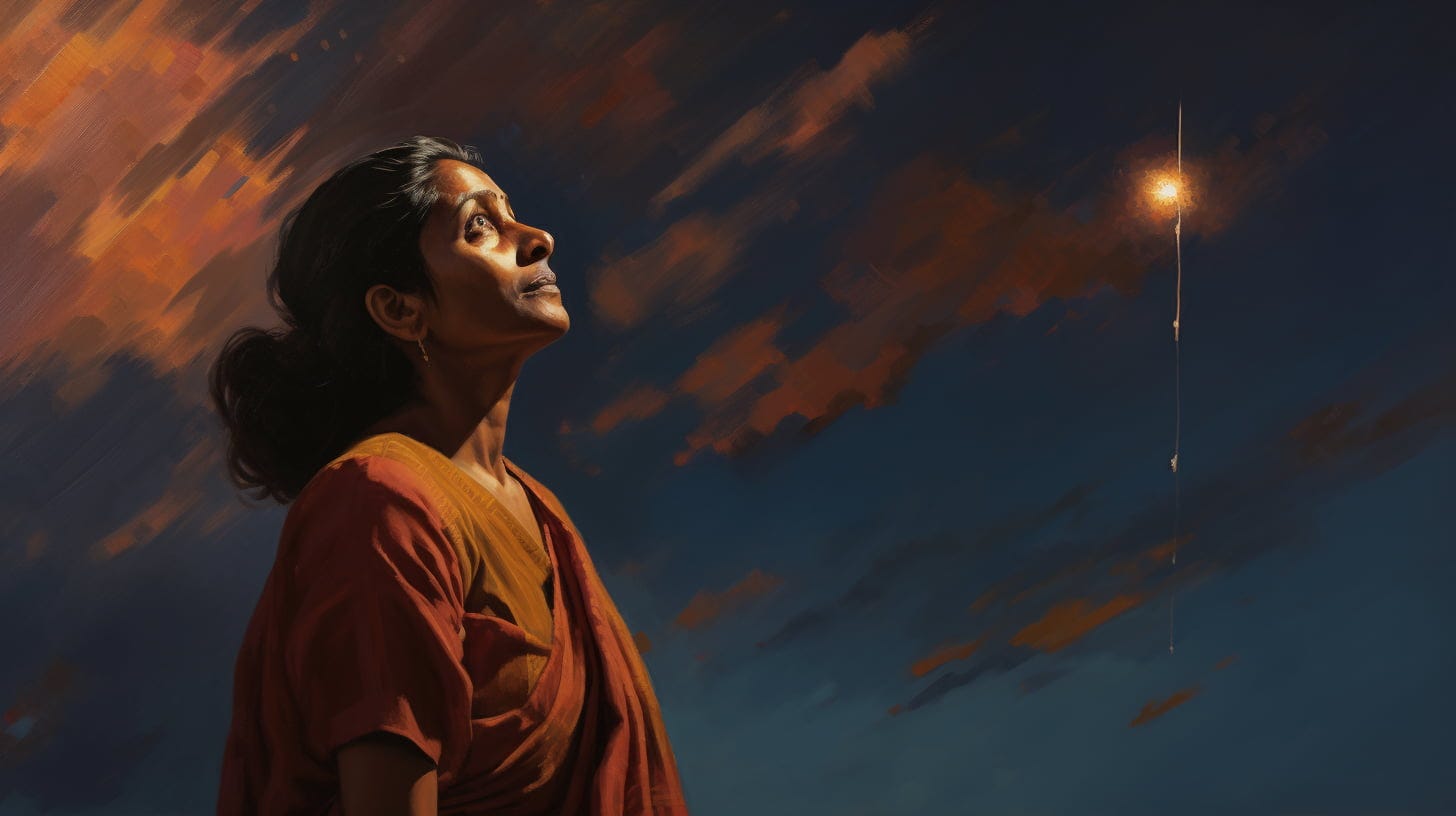5. Celestial Rebirth
Puducherry, with its charming streets and colonial architecture, lay nestled along the Bay of Bengal. The town, a beautiful blend of French elegance and Indian vibrancy, was the home of Mira, a woman with a fiery spirit. Her life's mission had been devoted to the preservation of the environment, inspired by the rapidly changing landscape of her hometown.
As the evening settled, Mira was engrossed in an ancient Sanskrit text in her home library. However, her solitude was disrupted by a call from her best friend Anaya, a scientist at the Indian Space Research Organisation (ISRO). Anaya relayed the harrowing revelation: Apophis, once believed to be a harmless celestial entity, was now on a direct collision course with Earth.
The news, once confined to whispers in corridors of power, became public knowledge. The vibrant streets of Puducherry were now awash with a mix of trepidation and contemplation. Broadcasts oscillated between grim predictions and spiritual reflections. The very fabric of human existence seemed under threat.
But Mira, ever the beacon of hope, saw an opportunity amidst the despair. She orchestrated a grand assembly in the heart of Puducherry, a model that would soon find echoes globally. Individuals were invited to share stories that celebrated humanity—tales of love, sacrifice, and moments that defined their lives.
A poignant realisation dawned during these gatherings. In confronting their end, people recollected moments of unbridled kindness, instances where humanity shone its brightest. The essence of what it meant to be human was rediscovered, and it was beautiful.
The fateful day, the one where Apophis would cast its shadow, arrived. Mira, flanked by thousands, stood on the beaches of Puducherry, their collective gaze turned skywards. Time seemed suspended.
Minutes turned into hours as they watched the dark shadow move across the sky, waiting for something to happen. Eventually, as dawn broke, the realisation came that the asteroid had narrowly missed Earth. The overwhelming sense of relief was palpable. Humanity had been granted a reprieve.
The post-Apophis world was starkly different. The experience had kindled a newfound appreciation for life's fragility. Mira, seizing this unique moment in history, proposed a global collaboration—one that would address poverty, environmental degradation, and education.
Astoundingly, the proposal gained traction. The world, now intimately familiar with its vulnerabilities, rallied behind Mira's vision. Borders became less rigid, and collective welfare emerged as the shared goal. Global initiatives rapidly took shape—deforestation was reversed, renewable energy was universally adopted, and hunger was systematically eradicated.
Puducherry stood as a testament to this transformation. Its beaches, once at risk, now thrived, and its historic buildings echoed with ideas and innovations.
In the years that followed, the tale of Apophis would be recounted, not as a doomsday prophecy, but as a story of humanity's resilience and unity. Mira, the passionate environmentalist from Puducherry, had become a global emblem of hope—a reminder that even on the brink, humanity could rediscover its essence and chart a path towards a brighter future.
Humanitas et Machina: This series of fictional short stories aims to bring visions of hope in the face of humanity’s biggest challenges while also exploring the risks and potential of a future with AI. All stories are co-creations between man and machine. All images are AI generated. Find out more about the project.
I chose to include a story of an asteroid because it is one of the threats facing humanity that is least spoken about. Ancient cultures had great awareness and reverence for these celestial objects and yet modern culture is largely unaware of the possibility. Apophis is a real asteroid that NASA originally predicted could be near miss in 2029 but later revised its calculations to say that it did not present a risk. Some have challenged the updated calculations and so it felt fitting to include this in the brief as the basis for the story. I asked how a near miss of this kind might impact humanity and help us to evolve our global culture to serve us all better.
I specified India as the location for this story and also requested a female lead character. There were a few false starts with the story but gradually I honed it in to soemthing that felt compelling and coherent. The big challenge was that once again, the AI seemed unrealistic in the ease with which the world could change and challenges could be solved. In the end I manually edited the end of the story to give some more solidity to Mira’s actions and acknowledge that he chances of success were slim.
When generating the image, I encountered three interesting problems. The first was that for some reason, when generating images of Indian women, the prompt for an oil painting style seemed to be largely ignored and the early images all looked like photographs or move renderings. The second was that I was unable to generate a single image that actually depicted a meteor in the sky above a person. The third was that I initially wanted Mira to be standing on the beach on Puducherry but as soon as I added “beach” to the prompt, all images looked like modelling shoots of young women in beachwear. Not the vibe I was going for! With a lot of fine tuning and let’s be honest “shooting in the dark”, I eventually generated this image which I felt captured the essence of the story and fitted with the image style of the series, even if the imagery of the asteroid and location itself is purely suggestive.




